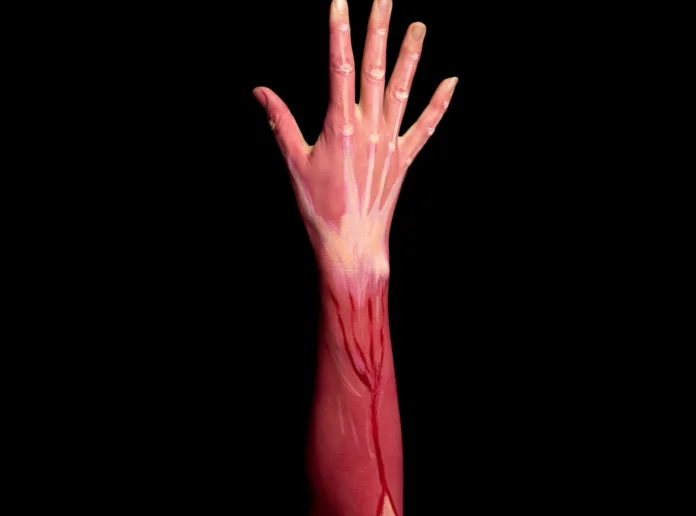Stanford researchers discover food dye transparency, showing how a common dye can make tissues transparent for medical applications
In a surprising new development, scientists at Stanford University have found that a common food dye, often used in products like Doritos and SunnyD, can temporarily make skin, muscle, and connective tissues transparent. This food dye transparency discovery has the potential to transform medical diagnostics by allowing physicians to see through the skin to internal organs without invasive surgery. This breakthrough opens new possibilities for non-invasive procedures and advanced research applications.
The research, led by Dr Guosong Hong, involved applying the yellow dye tartrazine to a mouse’s underbelly, making the abdominal skin clear enough to view the liver, intestines, and bladder. In a separate experiment, smearing the dye on the mouse’s scalp revealed blood vessels in the brain. The skin returned to its normal appearance once the dye was washed away, demonstrating that the process was both reversible and repeatable.
Embed from Getty ImagesDr Hong explained that the technique could lead to non-invasive ways of diagnosing conditions like deep-seated tumours, potentially reducing the need for biopsies. It could also assist in locating veins more easily for blood draws or monitoring internal conditions without surgery.
The discovery hinges on a principle similar to the concept of invisibility described in HG Wells’s The Invisible Man. By altering the way light interacts with tissues—specifically by reducing light scattering—the dye enables scientists to make the tissues see-through, particularly in the red spectrum of light. This food dye transparency discovery is the first to show that a dye can make an opaque material like skin or muscle transparent in this way. This breakthrough highlights the potential of food dye transparency to revolutionize medical imaging and diagnostics.
Although the process has not yet been tested on humans, the researchers believe that microneedle patches or injections could deliver the dye deep enough into the tissue for practical medical use. If proven safe, this approach could revolutionize both medical treatment and scientific research, enabling a new way to study internal body structures in real time.
Analysis
Political: This breakthrough in medical science could spur policy discussions surrounding the use of new technologies in healthcare. Regulatory bodies such as the FDA will need to closely evaluate the safety and ethical implications of using food-grade dyes in medical procedures. As researchers prepare for human trials, government agencies will play a pivotal role in determining how quickly this food dye transparency discovery can move from the lab to hospitals. Furthermore, there may be calls for updating medical guidelines and practices to incorporate this non-invasive method for diagnosing injuries or illnesses, potentially reducing the healthcare burden and offering alternatives to more invasive diagnostic procedures like biopsies.
Social: The social implications of this research are wide-ranging, especially in terms of access to less invasive medical care. For many patients, undergoing medical procedures such as biopsies can be anxiety-inducing and painful. This new technique could offer a less intrusive option, providing psychological relief as well as physical comfort. Moreover, this innovation speaks to a larger trend in medical science towards non-invasive technologies, which are increasingly in demand as societies become more focused on patient comfort and reduced recovery times. Public awareness of these options may also increase the expectation for faster, safer diagnostic tools in routine medical care.
Racial: While the study does not directly address race, the implications of such a medical breakthrough could indirectly benefit groups that face healthcare disparities. Communities of colour often encounter barriers to accessing high-quality medical care, including advanced diagnostics. If this technology becomes widespread, it could provide a more accessible and cost-effective method of detecting illnesses or injuries early. This transparency procedure, if implemented in underserved healthcare systems, could help mitigate some of these disparities, enabling quicker, less invasive diagnostics for a broader range of patients.
Gender: The gender implications of this discovery may surface in how it is applied to gender-specific medical conditions. For instance, this technique could be instrumental in diagnosing breast tumours or other conditions that disproportionately affect women, offering a faster and less painful alternative to mammograms and biopsies. Women, who often bear the brunt of invasive medical procedures for reproductive health issues, could particularly benefit from a technique that requires no surgical intervention. Moreover, in prenatal care, this non-invasive imaging technique might provide clearer diagnostic tools without exposing pregnant women to radiation.
Economic: From an economic standpoint, the implications of this discovery are enormous. Traditional imaging techniques, such as MRI and CT scans, are expensive and require significant resources, including specialized equipment and trained personnel. If this food dye technique proves to be a viable alternative, it could dramatically reduce healthcare costs by lowering the need for expensive imaging machines and procedures. In developing countries where advanced medical imaging technology may not be available, this method could become a cost-effective alternative, allowing for more widespread and timely diagnosis of conditions. The medical industry could see a major shift towards adopting this technique, potentially leading to a reduction in healthcare expenditure on invasive diagnostic methods.
